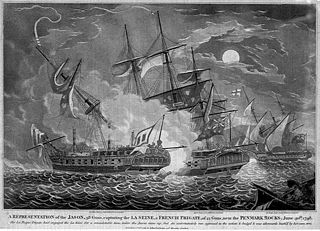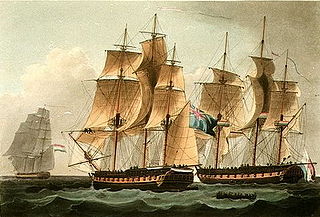Career
Lieutenant Joseph Edmonds commissioned Asp in April 1797, for the Channel.
In 1798 she participated in Sir Home Popham's failed attack on Ostend. While she engaged shore batteries four hours in support of a landing by troops she had one seaman killed, and Lieutenant Edmonds was wounded. [2]
Between 1798 and 1803 she was under the command of Lieutenant Isaac Ferriers.Asp and Biter shared in the proceeds of the capture on 18 June 1799 of the galliot Jane. [3]
In July 1800 Asp escorted a convoy to the West Indies.
Because Asp served in the navy's Egyptian campaign between 8 March 1801 and 2 September, her officers and crew qualified for the clasp "Egypt" to the Naval General Service Medal that the Admiralty issued in 1847 to all surviving claimants. [4]

HMS Goliath was a 74-gun third-rate ship of the line in the Royal Navy. She was launched on 19 October 1781 at Deptford Dockyard. She was present at the Battle of Cape St Vincent, Battle of the Nile, and Battle of Copenhagen. She was broken up in 1815.

HMS Diadem was a 64-gun third rate ship of the line of the Royal Navy, launched on 19 December 1782 at Chatham. She participated in the Battle of Cape St Vincent in 1797 under Captain George Henry Towry.
Mutine was an 18-gun Belliqueuse-class gun-brig of the French Navy, built to a design by Pierre-Alexandre-Laurent Forfait, and launched in 1794 at Honfleur. She took part in the Battle of Santa Cruz de Tenerife, where the British captured her. She was recommissioned in the Royal Navy as HMS Mutine, and eventually sold in 1803.

HMS Hazard was a 16-gun Royal Navy Cormorant class ship-sloop built by Josiah & Thomas Brindley at Frindsbury, Kent, and launched in 1794. She served in the French Revolutionary Wars and throughout the Napoleonic Wars. She captured numerous prizes, and participated in a notable ship action against Topaze, as well as in several other actions and campaigns, three of which earned her crew clasps to the Naval General Service Medal. Hazard was sold in 1817.

Seine was a 38-gun French Seine-class frigate that the Royal Navy captured in 1798 and commissioned as the fifth-rate HMS Seine. On 20 August 1800, Seine captured the French ship Vengeance in a single ship action that would win for her crew the Naval General Service Medal. Seine's career ended in 1803 when she hit a sandbank near the Texel.

Égyptienne was a French frigate launched at Toulon in 1799. Her first service was in Napoleon's Egyptian campaign of 1801, in which the British captured her at Alexandria. She famously carried the Rosetta Stone to Woolwich, and then the Admiralty commissioned her into the Royal Navy as the 40-gun fifth-rate frigate HMS Egyptienne. She served in a number of single-ship actions before being reduced to harbour service in 1807, and was sold for breaking in 1817.

HMS Wilhelmina was a 32-gun fifth rate frigate of the Royal Navy. She was previously a Dutch ship and had been built in 1787 for the Dutch Republic as the Wilhelmina. She was renamed Furie in 1795, after the establishment of the Batavian Republic as a client state of the First French Empire. Like other Dutch ships at that time, she was pressed into service as part of French plans to support the Irish Rebellion of 1798 in the hope of destabilising Britain. The British captured her and the Dutch corvette Waakzaamheid in 1798 while the two were supporting French and Irish forces involved in the Irish Rebellion. The Royal Navy took both into service, with Furie regaining her original name. Sailing as HMS Wilhelmina, she spent the bulk of her later career in the East Indies, serving mostly as a troopship. Here she fought an unequal battle against a large French privateer, and succeeded in driving her off and protecting a merchant she was escorting. Wilhelmina was almost the ship that faced a superior French squadron at the Battle of Vizagapatam, but she was replaced beforehand by the larger HMS Centurion. She spent the rest of her days as a guardship in Penang, and was sold there in 1813.
HMS Cynthia was a ship sloop of unusual design, launched in 1796. She took part in one medal-worthy boat action and participated in captures of a number of merchant vessels, was present at two notable occasions, the surrender of the Dutch fleet in the Vlieter Incident and the capture of Alexandria, and her crew participated in two land attacks on forts. She was broken up in 1809.
During the French Revolutionary and Napoleonic Wars the Royal Navy used several vessels that bore the designation His Majesty's hired armed cutter Lord Nelson, all named for Lord Horatio Nelson.
The British Royal Navy employed two vessels described as His Majesty's hired armed cutter Kent, the first during the French Revolutionary Wars, and the second during the Napoleonic Wars.
The Royal Navy used several vessels that were described as His Majesty's hired armed cutter King George. Some of these may have been the same vessel on repeat contract.
Two vessels have been named His Majesty's hired armed cutter Earl St Vincent.
HMS Fulminante was a cutter belonging to the French Navy that the British captured in 1798, the French recaptured in 1800, and the British re-recaptured three months later. She was wrecked early in 1801.

Etna was a French naval Etna-class ship-sloop launched in 1795 that the Royal Navy captured in November 1796. She was taken into service as HMS Aetna and renamed to HMS Cormorant the next year. She captured several merchant vessels and privateers before she was wrecked in 1800 off the coast of Egypt.
Salamine was originally the Spanish Navy's Infante 18-gun brig, built in 1787 at Cadiz. The French Navy captured her at Toulon in December 1793 and recommissioned her; they renamed her on 10 May 1798 as Salamine, for the battle of Salamis. On 18 June 1799, HMS Emerald captured her and she was brought into Royal Navy service as HMS Salamine. She served briefly in the Mediterranean, where she captured two French privateers and several merchant vessels before the Royal Navy sold her at Malta in 1802, after the Treaty of Amiens ended the war with France.
Mutin was a 14-gun cutter of the French Navy, the lead ship of the Mutin class of five naval cutters. She was launched in 1778 and the Royal Navy captured her the next year, taking her into service as HMS Mutine. The Royal Navy renamed her HMS Pigmy in 1798. She was lost in 1805.

HMS Cameleon was a Royal Navy Diligence-class brig-sloop, launched in 1795. She was built of fir, which allowed for rapid construction, but at the expense of durability. She captured some small vessels and a privateer, and served in the Mediterranean before being laid up in 1805, and broken up in 1811.
HMS Madras was laid down as Lascelles, an East Indiaman being built for the British East India Company (EIC). The Royal Navy purchased her on the stocks and had her completed as a 56-gun fourth-rate. She was launched as HMS Madras in 1795, and served in the Leeward Islands and the Far East. In 1801, she was armed en flûte and served in the Mediterranean, first participating in the British campaign to drive Napoleon from Egypt. From 1803, she served as a guard ship at Malta and was broken up there in 1807.
Between 1793 and 1805, five cutters served the British Royal Navy as hired armed vessels under the designation HM hired cutter Rose:
HMS Tartarus was the mercantile Charles Jackson, launched in 1792 at Newcastle. She traded with Saint Petersburg until the British Royal Navy purchased her in 1797 and converted her to a bomb vessel. She served in two campaigns before she was lost in a gale on 20 December 1804.







